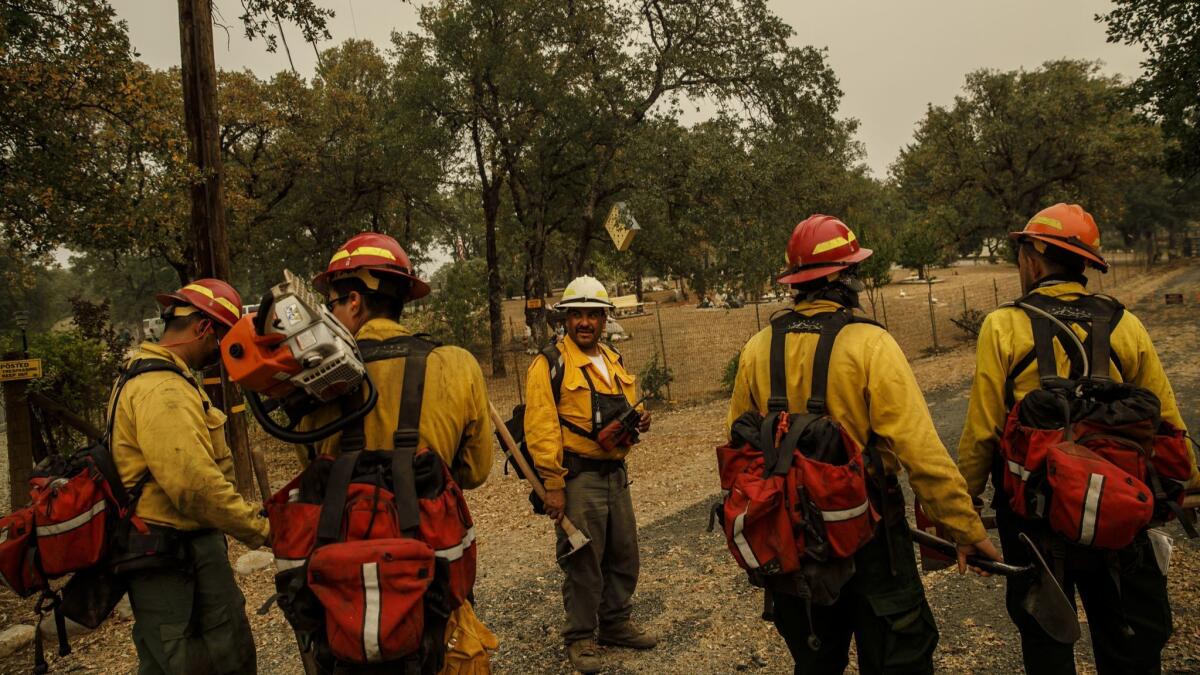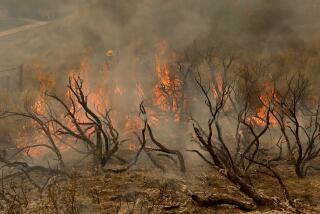Must Reads: In a conservative Northern California county, a team of Mexican immigrants helps battle the Carr fire

Reporting from Redding, Calif. — Behind River Ridge Terrace in Redding, where the monstrous Carr fire had destroyed homes, a team of 20 men used shovels to stab the charred earth.
Under the blazing sun, the clinking of metal stopped when one of the men scooping dirt out from under a tree spotted smoke rising from the ground.
“Humo!” he shouted in Spanish.
From afar, the mop-up operation was typical firefighting work, with one exception — it was being done by mostly Mexican immigrants who spend their off-seasons picking oranges, lemons and cherries across Washington, Oregon and California.
Each year, thousands of immigrants work as wildland firefighters, plying the trade at a time when extreme weather is producing larger and more destructive fires in the West.
“I’d say for the last 15 years, the Hispanic population started to get more involved in this kind of work,” said Federico Rocha Sr., a Mexican immigrant and the team’s boss.
The private contract crew arrived five days ago in Redding, conducting control burns and mop-up work in an effort to help fight the wildfire that swept through Shasta and Trinity counties and killed six people, including two children and two firefighters.
The fire has devoured more than 1,000 homes and scorched more than 130,000 acres.
Officials said more than 13,000 firefighters are currently on duty, fighting nearly 20 large fires that have burned more than 410,000 acres and displaced more than 40,000 residents across the state. Seventeen states have offered assistance to California during the last week, sending help from as far away as Maine and Florida.
Officials say the fire conditions and the amount of firefighting resources devoted to control wildfires may become the new norm.
For the first time in its 110-year history, the U.S. Forest Service has spent more than 50% of its budget to suppress the nation’s wildfires. Fire seasons are also 78 days longer than in 1970s, according to the U.S. Department of Agriculture.
Under these conditions, every bit of muscle helps — and field workers know hard labor.
A 2007 report by the American Immigration Council found that a significant number of wildland firefighters were immigrants, mostly Mexican-born men.
Shasta County is Trump country. The president won the county with 65% of the vote. In February, Shasta County voted to become a “non-sanctuary” zone for immigrants in the country illegally.
But for the fire crew of Mexican immigrants, politics never enters the mind. This isn’t about Trump or his supporters, or about border walls. It’s about the pride of protecting people’s homes. Rocha said residents have been grateful.
“When people appreciate what we do, it makes us feel good,” he said. “Even at stores, people thank us and they’re happy we’re here helping.”
The fire crew was trained and hired by R&R Contracting, a private company based in Salem, Oregon, and operated by one of Rocha’s relatives. The company is also just one of hundreds in Oregon that are contracted by state and federal governments to fight forest fires.
Experts say Oregon is in the forefront of states that have created certification programs for contract firefighters. A sizable number of them are Latino immigrants.
The California Department of Forestry and Fire Protection could not immediately say what percentage of its firefighters were immigrants.
From an observational standpoint, Mike Mohler, deputy director of communications for Cal Fire, said the department is pretty diverse.
“I know we have Russians and we have Mexicans represented up and down the state,” he said. “We should have a decent influence, but now I’m curious.”
The overall population of immigrant firefighters in California appears to be growing.
It nearly doubled in the last five years, according to data from the Public Policy Institute of California, a non-profit and non-partisan research institution. There were 2,408 immigrant firefighters in California in 2016, compared to 1,288 in 2011.
Many fire agencies and organizations don’t keep track of the number of immigrant firefighters, but according to the 2016 data from institution, immigrants made up 7% of the firefighter population in California. There was a total of 35,499 firefighters that year in the state and of that number 33,091 were native born firefighters and 2,408 were immigrant firefighters. The data includes municipal, county, state and wild land firefighters.
Leaning on his shovel, sweating, 46-year-old Juan Cisneros, a Mexican immigrant, said it was his second year with the crew.
In the off-season, he’s out picking mostly oranges in Visalia, earning money to help care for his wife and four daughters.
“This job is hard and a little dangerous,” he said. “But you have to do what you can for the family.”
Cisneros, who is from Michoacán, said the job is hard work because of the heavy gear and intense labor.
“It can get tiring,” he said, adding that while it is physically challenging, it is rewarding.
“I feel important when someone says thank you for the work we do,” he said. “When we’re walking around people say thank you to us for being here and fighting a fire.”
Cisneros said he doesn’t like what he hears on the news about immigrants, but he tries to simply ignore it. He hopes critics of immigrants will pay attention to the work he and others do.
“I want them to see our contributions here,” he said.
Pablo Araujo, who picks cherries in Washington during the off-season, said the job has been growing on him.
“I’ve spent most of my life picking cherries,” he said. “But now, I don’t know. This job is interesting.”
Along Quartz Hill Road, where the men were trying to scrape dirt away to get to the smoldering roots of a tree, a man in a white truck drove by with his head out the window.
“Good work guys!” he yelled, giving a thumbs up. “Thank you!”
For more Southern California news, follow @latvives on Twitter.
More to Read
Sign up for Essential California
The most important California stories and recommendations in your inbox every morning.
You may occasionally receive promotional content from the Los Angeles Times.











